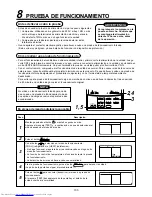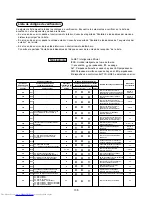
WARNINGS ON REFRIGERANT LEAKAGE
For the amount of charge in this example:
• The possible amount of leaked refrigerant gas in
rooms A, B and C is 10 kg.
• The possible amount of leaked refrigerant gas in
rooms D, E and F is 15 kg.
Note 2 :
The standards for minimum room volume are as follows:
(1) No partition (shaded portion)
(2) When there is an effective opening with the adjacent
room for ventilation of leaking refrigerant gas
(opening without a door, or an opening 0.15% or
larger than the respective floor spaces at the top or
bottom of the door).
(3) If an indoor unit is installed in each partitioned room
and the refrigerant tubing is interconnected,
attention must be paid to ensure safeguards are in
place to avoid density limits being exceeded in each
partitioned area.
When leak detection is interlocked with mechanical
ventilation equipment is installed in the smallest
room where the density limit is exceeded, the
volume of the next smallest room becomes the
object.
Note 3 :
The minimum indoor floor area compared with the
amount of refrigerant is roughly as follows
(when the ceiling is 2.7 m high):
Refrigerant density limit
The room in which the air conditioner is to be
installed should be designed or chosen such
that in the event of a refrigerant gas leak the
density of gas should not exceed a set limit.
The refrigerant R-410A, which is used in the air
conditioner product, is intrinsically safe without the
toxicity or combustibility of ammonia.
R-410A is environmentally friendly and is not restricted
by current or pending laws intended to protect the ozone
layer.
Risk of suffocation through leakage of R-410A is
minimal. However, with the recent increase in the
number of high density buildings and use of multi air
conditioner systems to ensure effective use of floor
space, energy conservation and individual control,
installers should ensure it is not possible to exceed
density limits in the event of a refrigerant leak.
In particular, where a single unit of the multi conditioner
system is to be installed into a small room, select a
suitable model and installation procedure so that if
refrigerant leaks out, density limits are not exceeded.
In a room where there is a risk of the density limit being
exceeded, create an opening with adjacent rooms, or
install mechanical ventilation combined with a gas leak
detection device.
The density can be calculated as shown below;
Total amount of refrigerant (kg)
Min. volume of the indoor unit installed room (m³)
≤
density limit (kg/m³)
The density calculation must be carried out in
accordance with BS EN 378.
The above procedure must be completed in accordance
with local, national and international standards, code of
practice and statutory requirements.
Note 1 :
If there are 2 or more refrigerating systems in a single
area, the amount of refrigerant should be charged as
required for each individual unit.
Important
Outdoor unit
e.g.,
charged amount (15kg)
e.g., charged
amount (10kg)
Indoor unit
Room A Room B Room C Room D Room E Room F
Outdoor unit
Refrigerant piping
Indoor unit
Outdoor unit
Refrigerant piping
Indoor unit
Very
small
room
Small
room
Medium
room
Large room
Mechanical ventilation device - Gas leak detector
0
5
10
10
20
30
15
20
25
30
35
40
Range below the
density limit
of 0.3 kg/m³
(countermeasures
not needed)
Range above
the density limit
of 0.3 kg/m³
(countermeasures
needed)
Total refrigerant amount
kg
Min.
indoor floor area
m²
Содержание MMU-AP0071MH
Страница 145: ...EH99847001 ...


































